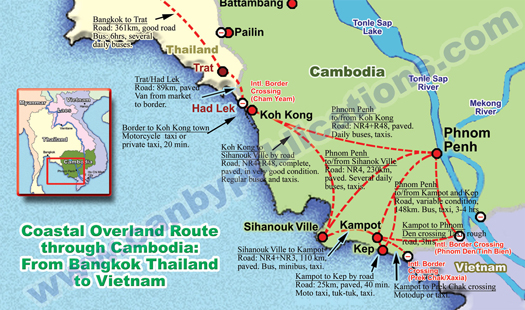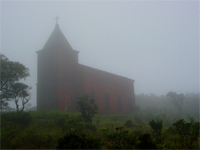Krong Kep,
Cambodia
|
|
--------------------------------------------------------------------------------
Getting to Kep
KAMPOT to/from KEP
‘Start at the durian, left at the dove,
past the rhino, right at the white horse, on to the blue crab, and
you’re there.’
The road from Kampot to Kep is paved and picturesque. It’s a 25km, 30-45 minute trip though scenic Cambodian countryside. There are some newly broken stretches of pavement but that will probably be repaired after the end of the wet season.
From Kampot, follow the Road 33 east to the White Horse Monument intersection. Bear right. At the next main turnoff (a small roundabout with a Vishnu statue,) turn right onto the oceanfront road to go to the Crab Market or continue straight past to Kep Beach.
**Motorcyclists, be aware of some uneven pavement and invisible humps in the tarmac on Road 33.
Motodups from Kampot start at about $3-$4 one way and $8-$10 round trip. Tuk-tuks run about $10-$17 for a round trip depending how long you spend in Kep and number of passengers.
The road from Kampot to Kep is paved and picturesque. It’s a 25km, 30-45 minute trip though scenic Cambodian countryside. There are some newly broken stretches of pavement but that will probably be repaired after the end of the wet season.
From Kampot, follow the Road 33 east to the White Horse Monument intersection. Bear right. At the next main turnoff (a small roundabout with a Vishnu statue,) turn right onto the oceanfront road to go to the Crab Market or continue straight past to Kep Beach.
**Motorcyclists, be aware of some uneven pavement and invisible humps in the tarmac on Road 33.
Motodups from Kampot start at about $3-$4 one way and $8-$10 round trip. Tuk-tuks run about $10-$17 for a round trip depending how long you spend in Kep and number of passengers.
PHNOM PENH to/from KEP
Road
There are two routes to Kep from Phnom Penh: 1) Follow National Route #3 (NR3) to Kampot and then take Road 33 to Kep (see previous section); 2) Follow National Route #3 (NR3) to the fork at Road 31. (There is a petrol station in the center of the fork.) Bare left. Take Road 31 south to Kampong Trach city. (Road 31 passes through some beautiful countryside.) Turn right at Kampong Trach and proceed to the Kep loop turnoff. Look for large overhead signs marking the turnoff. This route bypasses Kampot.
Taxis
Private taxi: Private taxis run about $40-$45.
Bus
Three or four bus companies run regular daily buses from Phnom Penh to Kep, combining the destinations of Kampot and Kep, some going to Kep first, some Kampot. To shorten the trip make sure to get a bus that stops at Kep first. In Kampot the buses arrive/depart the bus station on the east side of town. In Kep the buses arrive/depart at the Kep Beach intersection.
Phnom Penh Sorya Transport Bus
PP to Kep (direct) : 7:30, 9:30 12:00, 14:30, (18,000R/pax)
Kep to PP : 6:45, 7:00, 12:30, 13:30 (11,000R/pax)
Full-size a/c buses
Phnom Penh Station: Next to the Central Market.
Capitol Tours and Transport
PP to Kep (direct) : 7:00, 13:00 (15,000R/pax)
Kep to PP : 7:00, 13:00 (12,000R/pax)
Full-size a/c buses
Phnom Penh Station: Capitol Guesthouse, corner of Streets 107 and 182.
Road
There are two routes to Kep from Phnom Penh: 1) Follow National Route #3 (NR3) to Kampot and then take Road 33 to Kep (see previous section); 2) Follow National Route #3 (NR3) to the fork at Road 31. (There is a petrol station in the center of the fork.) Bare left. Take Road 31 south to Kampong Trach city. (Road 31 passes through some beautiful countryside.) Turn right at Kampong Trach and proceed to the Kep loop turnoff. Look for large overhead signs marking the turnoff. This route bypasses Kampot.
Taxis
Private taxi: Private taxis run about $40-$45.
Bus
Three or four bus companies run regular daily buses from Phnom Penh to Kep, combining the destinations of Kampot and Kep, some going to Kep first, some Kampot. To shorten the trip make sure to get a bus that stops at Kep first. In Kampot the buses arrive/depart the bus station on the east side of town. In Kep the buses arrive/depart at the Kep Beach intersection.
Phnom Penh Sorya Transport Bus
PP to Kep (direct) : 7:30, 9:30 12:00, 14:30, (18,000R/pax)
Kep to PP : 6:45, 7:00, 12:30, 13:30 (11,000R/pax)
Full-size a/c buses
Phnom Penh Station: Next to the Central Market.
Capitol Tours and Transport
PP to Kep (direct) : 7:00, 13:00 (15,000R/pax)
Kep to PP : 7:00, 13:00 (12,000R/pax)
Full-size a/c buses
Phnom Penh Station: Capitol Guesthouse, corner of Streets 107 and 182.
Getting AROUND
Kep
Tuk-tuks await passengers at the bus station, Crab Market, beachfront and other tourist locations. Most hotels can arrange a motorcycle rental. There are also a couple of rental places around the beach intersection. Some rent bicycles as well. Motorcycle rental runs around $4-$6/day for a 100-125cc bike and $5-$10/day for a 250cc.
Tuk-tuks await passengers at the bus station, Crab Market, beachfront and other tourist locations. Most hotels can arrange a motorcycle rental. There are also a couple of rental places around the beach intersection. Some rent bicycles as well. Motorcycle rental runs around $4-$6/day for a 100-125cc bike and $5-$10/day for a 250cc.
Kep Dining
Kep is known for its fresh seafood, especially the crab, which is absolutely excellent - literally straight from the ocean to your plate. No visit to Kep is complete without at least one fresh seafood lunch or dinner at the oceanfront. The Kampot Pepper Crab is a local culinary classic - fresh from ocean crab fried or steamed with generous bunches of fresh green and black Kampot pepper corns, some of the finest, most famous pepper in the world.
Traditional dining venues include the Crab Market and pockets of dining gazebos strung along the seaside. The Crab Market is made up of a dozen rustic oceanfront crabshack restaurants, most with a very local, friendly atmosphere offering a wonderfully unsophisticated dining experience at the water’s edge. As the Crab Market has become more popular over the last few years some of the restaurants have become a bit too accustomed to tourists, reducing portions and raising prices. Generally speaking, the touristy places are slicker and easier but the scruffier places more authentic and down-home.
At Kep Beach, picnic platforms line the road and another group of platforms line the Oceanside park near the Big Crab statue. Just find an empty platform, sit down and the seafood vendors will come to you. Most of the vendors have English language menus. Place your order and they’ll have your seafood cooked and served within 10 minutes.
Almost all of the hotels and guesthouses in Kep have restaurants and bars, some quite good. Most serve a wider variety of dishes than the local vendors including western and international dishes as well as fresh seafood dishes. Several guesthouse restaurants are located along Road 33a within a few hundred meters of the oceanfront road traffic circle.
After dark, most of Kep closes down, though a few places including Breezes on the beach, Toucan Bar in the Crab Market, and Kep Rock Cafe near the Vishnu statue restaurant, as well as some of the guesthouse restaurants are open into the late evening. Some of the seafood shacks at the Crab Market stay open as late as 10PM or 11PM.
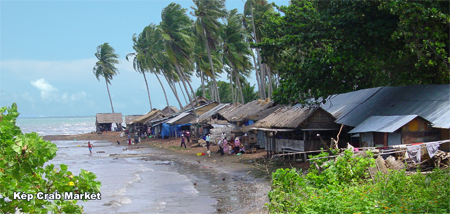
Kep
Guesthouses and Hotels
A couple of dozen hotels and guesthouses
are scattered across the Kep peninsula. Several sit amongst the
jungle vegetation on side of the mountain overlooking the ocean.
Others dot the ocean’s edge, including a small cluster of places at
the Kep Beach intersection and a couple of new guesthouses near the
Rabbit Island boat dock. Kep, in general, is aiming at
mid/upper-range tourists and though there are plenty of budget
priced rooms available, on the whole accommodations in Kep are bit
more upscale and expensive than other coastal towns.
Kep
Shopping
Kep’s first convenience store recently opened and another is on the way. Long Villa Mart located at the Rabbit Island boat dock is pretty well stocked offering beer, wine, spirits, foods, meats, soft drinks, snacks, and beach clothes.
Kep’s first convenience store recently opened and another is on the way. Long Villa Mart located at the Rabbit Island boat dock is pretty well stocked offering beer, wine, spirits, foods, meats, soft drinks, snacks, and beach clothes.
Kampot and Kep are so close to each
other that they share many of the same sights and attractions. Kep
Beach, Rabbit Island, Bokor Hill Station, and countryside tours are
perhaps the most popular day tours out of Kampot and Kep with tour
operators offering very competitively priced tours. The Kampot/Kep
area also offers several other attractions including pre-Angkorian
ruins and caves, jungle trekking, bicycling tours, river cruises,
island trips, fishing trips, isolated beaches, pepper plantations,
bamboo train rides and some beautiful rural countryside.
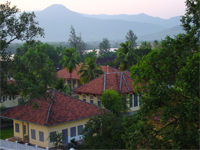 Architecture of Kampot
Architecture of KampotThough suffering a bit the ravages of time, the architecture of Kampot is pleasantly provincial, a mix of red tile-roofed shophouses and old French colonial government buildings. Kampot has been an active settlement for centuries but the location and layout of the modern town was established during the French colonial period in the late 19th/early 20th centuries. Many of the buildings along and near the river were constructed during this period. The south end of town harbors several European-style buildings including the governor’s mansion and the old prison. Most of the other colonial era buildings employ the classic 2-storey ‘Chinese shophouse’ design, many displaying European design elements. Unlike many other Cambodian cities, the shophouses are often individuated in design and facade, lending to Kampot town’s quaint air.
Tours to Bokor have been long been
popular out of Kampot. The Bokor Hill Station on Phnom Bokor (Bokor
Mountain) is a mountaintop collection of buildings (hotel, casino,
church, royal residence, etc.), constructed by French authorities in
the early 1920s as a complement to the already popular Kep resort
area. In the 1990s a travel author referred to Bokor as ‘the eeriest
place in the world.’ In its time, Bokor was an elegant getaway for
French officials and foreign visitors to old Indochina - a classic
colonial ‘hill station’ located in the mountains to allow foreigner
visitors accustomed to more temperate climes to escape the tropical
heat. Years of neglect left ghostly ruins - vestiges of a different
age, often shrouded in fog and clouds, though a new development
project amongst the old ruins has detracted some from the eerie
atmosphere. One thing that the years have not changed is the
absolutely spectacular view of the coast and the cool (sometimes
cold) mountain air. Bokor Mountain is jungled and excursions beyond
Bokor, including trekking, can be arranged by local tour operators.
The road up Bokor Mountain and the area of the old hill station are currently undergoing a development project, including refurbishing the casino and hotel and the addition of a new hotel complex. Though work continues on the new hotel and casino, the road up the mountain has recently been completed, is in good condition and is now open to visitors. The drive to the top take 30-45 minutes. Full day Bokor tours can be arranged through your guesthouse or a local tour operator. Tours run about $10/person inclusive for an all-day tour including a sunset boat cruise on the Kampong Bay River. Overnights can also be arranged (bring warm clothing!) Currently there is no admission fee. The Park Office and turn-off to the Hill Station are 37km west of Kampot on National Route 3.
The road up Bokor Mountain and the area of the old hill station are currently undergoing a development project, including refurbishing the casino and hotel and the addition of a new hotel complex. Though work continues on the new hotel and casino, the road up the mountain has recently been completed, is in good condition and is now open to visitors. The drive to the top take 30-45 minutes. Full day Bokor tours can be arranged through your guesthouse or a local tour operator. Tours run about $10/person inclusive for an all-day tour including a sunset boat cruise on the Kampong Bay River. Overnights can also be arranged (bring warm clothing!) Currently there is no admission fee. The Park Office and turn-off to the Hill Station are 37km west of Kampot on National Route 3.
Limestone mountains (‘phnom’) dot the
landscape between Kampot and Kep. Many contain limestone caves, some
adorned with exotic rock formations, and almost all containing
Buddhist shines. Make sure to bring a torch and wear shoes suitable
for climbing on rocks.
 The caves of Phnom Chhnork - Cave #1
Pre-Angkorian ruin set in a limestone cave amongst stalagmites
and stalactites that are slowly growing back into the ruin. Small,
4th-5th century AD brick structure associated with the ancient state
of Funan. A bit of carving is still visible. Look for the limestone
formations near the entrance of the cave in the shapes of elephants.
Cave #2 The entrance is about 300 meters from Cave #1 in the
same limestone outcropping. Very little in the way of formations,
but quite deep, requiring climbing over piles of rock and through
small openings. Small shrine.
The caves of Phnom Chhnork - Cave #1
Pre-Angkorian ruin set in a limestone cave amongst stalagmites
and stalactites that are slowly growing back into the ruin. Small,
4th-5th century AD brick structure associated with the ancient state
of Funan. A bit of carving is still visible. Look for the limestone
formations near the entrance of the cave in the shapes of elephants.
Cave #2 The entrance is about 300 meters from Cave #1 in the
same limestone outcropping. Very little in the way of formations,
but quite deep, requiring climbing over piles of rock and through
small openings. Small shrine.
The cave at Phnom Sla Ta'aun Plain by
comparison to other caves, but still an interesting climb. Look for
the huge rock balanced in a hole in the ceiling. Small shrine.
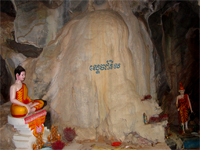 The cave at Phnom Sasear, also known as
the ‘White Elephant Cave.’ Located next to an colorful pagoda. The
stairs up the side of the outcropping provide a beautiful view of
the countryside, especially during the wet season. The cave contains
a shrine at the base of a limestone formation alleged to resemble a
white elephant.
The cave at Phnom Sasear, also known as
the ‘White Elephant Cave.’ Located next to an colorful pagoda. The
stairs up the side of the outcropping provide a beautiful view of
the countryside, especially during the wet season. The cave contains
a shrine at the base of a limestone formation alleged to resemble a
white elephant. 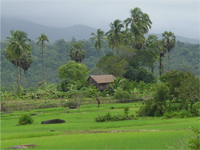 Countryside/Area Tours
Countryside/Area Tours
Kampot and
Kep provinces harbor some beautiful rural countryside just outside
the town areas - bucolic scenery, rice paddies and water buffalos
with white egrets riding their backs, countryside pagodas and little
villages filled with traditional stilted houses. There is some very
nice rural scenery along the road between Kampot and Kep. Keep your
camera at the ready. Tour operators offer full and half day area
tours the can easily be customized to your requirements, often
including visits to the caves, a pepper plantation, Kep, Rabbit
Island, Kampong Trach and a sunset cruise on the Kampong Bay River.
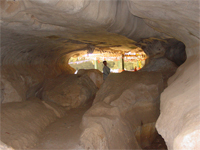 Kampong Trach
Kampong Trach
Kampong Trach is the district that borders Vietnam. The road trip
from Kampot to the main town passes though some picturesque rural areas.
There is a new side road to Kampong Trach town that skirts the base
of Phnom Voar, (where the victims of the 1994 Khmer Rouge
kidnappings were held.) These mountain areas of Kampong Trach were one
of the last Khmer Rouge holdouts. Kampong Trach town is small and
relatively uninteresting. The area’s main attraction is a series of
limestone caves and tubes that have been carved into a nearby mountain.
The roof of a large cave in the center of a mountain has collapsed,
making a small, enclosed jungle. Pagodas and shrines have been built
amongst the caves, providing for some excellent photo possibilities.
Bring a flashlight and wear good walking shoes.
From Kampot, take the Kep road, bear left at the White Horse Monument and follow to Kampong Trach. After a few kilometers the road changes to badly broken pavement. The side road mentioned above requires a left turn onto a graded dirt road about 7 km past the White Horse Monument. It is not a straightforward route and it may be better if you go with a guide. Set aside the better part of a day for the trip to the caves and back.
From Kampot, take the Kep road, bear left at the White Horse Monument and follow to Kampong Trach. After a few kilometers the road changes to badly broken pavement. The side road mentioned above requires a left turn onto a graded dirt road about 7 km past the White Horse Monument. It is not a straightforward route and it may be better if you go with a guide. Set aside the better part of a day for the trip to the caves and back.
Kampot Pepper and Pepper Plantations
Kampot pepper, grown in Kampot province, has been renowned for more than a century as some of the highest quality pepper in the world - its distinct flavor and pugnacity, intense but light taste with fresh lingering aromas has long been a prized as an essential spice in the finest French kitchens. It is also featured in local Kampot/Kep cuisine such as Pepper Crab (local crab fried in black or green pepper corn) and beef steak in fresh pepper corn sauce. At the beginning of the 20th century the Kampot plantations were in full operation and Cambodia was exporting more than 8000 tones of pepper annually. In 1960, there were 1 million pepper poles in Kampot. But the wars from the 1970s through the 1990s put an end to regular production for almost 30 years. Production was renewed in the late 1990s but faced new challenges. Pepper plantations now dot Kampot province. Most general Kampot area tours pass through the pepper plantations near Phnom Voar. The plantations of Angkor Chey near Phnom Voar offer a particularly good look at the process or growing and preparing the pepper. And it’s a good place to buy the Kampot pepper straight from the source.
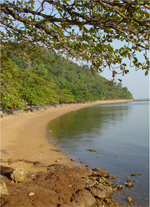 Kep Beach
Kep Beach
Kampot pepper, grown in Kampot province, has been renowned for more than a century as some of the highest quality pepper in the world - its distinct flavor and pugnacity, intense but light taste with fresh lingering aromas has long been a prized as an essential spice in the finest French kitchens. It is also featured in local Kampot/Kep cuisine such as Pepper Crab (local crab fried in black or green pepper corn) and beef steak in fresh pepper corn sauce. At the beginning of the 20th century the Kampot plantations were in full operation and Cambodia was exporting more than 8000 tones of pepper annually. In 1960, there were 1 million pepper poles in Kampot. But the wars from the 1970s through the 1990s put an end to regular production for almost 30 years. Production was renewed in the late 1990s but faced new challenges. Pepper plantations now dot Kampot province. Most general Kampot area tours pass through the pepper plantations near Phnom Voar. The plantations of Angkor Chey near Phnom Voar offer a particularly good look at the process or growing and preparing the pepper. And it’s a good place to buy the Kampot pepper straight from the source.
 Kep Beach
Kep Beach
A single, kilometer-long crescent of sand near the tip of the Kep
peninsula, bounded by rocks at either end and the oceanfront road
along the back. Coarse sand, shallow, warm water. Very average
swimming beach. But still lounge, have an oceanside seafood meal and
enjoy the cool sea breeze. Dining platforms and seafood vendors line
the road behind the beach as well as the oceanfront further down the
road near the Big Crab statue. The beach can be quite busy on
weekends, but often deserted during the week. The road through Kep
traces the coastline to the beach and then circles back on itself.
Sometimes cars and vans must pay admission to drive the oceanfront
road along the beach area (2500R-5000R). Motorcycles and pedestrians
are free. Be aware that the oceanfront road along the beach area is
a one way street and the police do occasionally enforce the law.
Khmer Cultural Development Institute
Located in Kampot town. Local school of traditional Khmer music and dance for young Cambodian students. The school allows visitors to observe the students in practice and occasionally holds formal performances.. Check the bulletin board in front of the school for visiting hours to observe practice sessions and performance announcements. Whether attending a training session or a performance, donations are welcome.
Located in Kampot town. Local school of traditional Khmer music and dance for young Cambodian students. The school allows visitors to observe the students in practice and occasionally holds formal performances.. Check the bulletin board in front of the school for visiting hours to observe practice sessions and performance announcements. Whether attending a training session or a performance, donations are welcome.
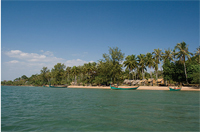 Rabbit Island
Rabbit Island
Rabbit
Island is a small tropical island located about 20-40
minutes south of Kep by local boat. The island is blessedly
undeveloped and lacks most services except for some rustic bungalows
and a couple of rudimentary beach shack restaurants. Secluded white
sand beaches dot the edges of the island, backed by a hilly coconut
palm interior. Most services are near the west side beach. The
surrounding waters are relatively clear and warm, offering some
snorkeling opportunities around the rocks. Coral is scarce but
colorful fish abound. You can stay on the island or make a day trip
of it - go in the morning, lounge on the beach and return to Kep in
the afternoon. Rooms/bungalows on the island run $10 or less.
Arrange a boat trip to the island through your guesthouse in Kampot
or Kep or just go to the Koh Tunsay Boat Dock in Kep town next to
the Long Villa Restaurant (see Kep map on page 113.) Boats
are almost always available. A round-trip trip to the island and
back runs $20 for the whole boat, so bring some friends to split the
cost. The round-trip price is the same whether you stay a few hours
or a few days. Tour operators and guesthouses in Kep offer day
packages starting at about $7/person inclusive.
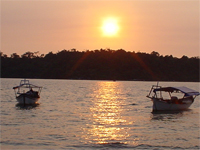 River Trips
River Trips
 River Trips
River Trips
River boat trips out of Kampot on the picturesque
Kampong Bay River are becoming more popular. The tour companies and
many of the guesthouses (Little Garden Bar) are offer several
different sorts of boat trips including short sunset trips upriver
to the Tekchhou Rapids; longer cultural/wildlife/eco trips upriver,
often combined with trekking in the National Park; downriver trips
to the ocean to explore the beaches and sand spits near the river’s
mouth; do a bit of ocean swimming; photograph the fishing boats at
work or go ocean fishing. A couple of the tour operators including
those listed can supply fishing gear. Boat trips are relatively
reasonably priced and the tour operators are generally amenable to
customizing the trip to your requirements.
Tekcchou Resort and Zoo
Tekcchou Resort and Zoo
A long-popular local picnic area on the
Prek Chha river near a set of rapids with riverside dining platforms
and lots of food/drink vendors. Though the cool rapids and river
breeze can be quite pleasant, the new river dam/hydroelectric
project just upstream of the rapids have diminished both the
atmosphere and popularity of the area. Nearby Asian-style mini zoo
displaying a variety of local fauna. 8km. Good road. Officials
sometimes collect an entrance fee, especially at peak times. At last
report, $3 for foreigners and 1000 riel for Cambodians.
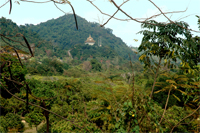 Trekking around Kep
Trekking around Kep
Offering a fairly easy hiking experience, a trail/service road snakes through national forest land around Kep Mountain - the small mountain near the tip of the peninsula between Road 33a and the Kep town area. The gently sloping trail winds past a couple of old pagodas, though light jungles where you may spy monkeys or other wildlife, and provides many picturesque overlooks along the way. Kampot and the Elephant Mountains can be seen in the distance from the northwest viewpoint, and the trail on the other side of the mountain provides some striking views across the valley to a pagoda on the next mountain and the beaches in the distance. The trail is actually a small, dirt service road that rings the mountain in an 8km loop, part of the road in pretty good condition, some narrow and overgrown. Suitable to hike of for a mountain bike or dirt bike. The trail is most easily and conveniently accessed from the road next to Le Bout du Monde and Veranda Guesthouse. The hiking is fairly easy, but wear stout shoes and take water and mosquito repellent.

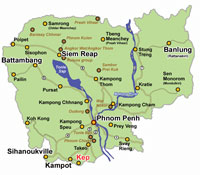
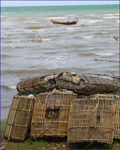 known
more for its oceanfront crab shacks and relaxed tropical
atmosphere. A few short, picturesque slivers of sand dot the
shore including Kep Beach where many of the guesthouses and
restaurants are clustered. The probably on the cusp of major
developments, Kep still has a rustic feel to it - jungled
mountains, quiet beaches, crab shacks and a steadily growing
number of hotels and restaurants. Kep is a place to relax
and dine by the seaside and use as a base to visit Rabbit
Island (Koh Tunsay,) to explore the national park, to see
the nearby caves and rural countryside. .
known
more for its oceanfront crab shacks and relaxed tropical
atmosphere. A few short, picturesque slivers of sand dot the
shore including Kep Beach where many of the guesthouses and
restaurants are clustered. The probably on the cusp of major
developments, Kep still has a rustic feel to it - jungled
mountains, quiet beaches, crab shacks and a steadily growing
number of hotels and restaurants. Kep is a place to relax
and dine by the seaside and use as a base to visit Rabbit
Island (Koh Tunsay,) to explore the national park, to see
the nearby caves and rural countryside. .